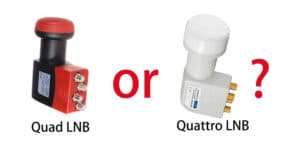In satellite television systems, the LNB (Low Noise Block Down Converter) plays a pivotal role in capturing and converting satellite signals for reception by satellite receivers. Among the various types of LNBs available, Quattro LNB and Quad LNB are highly favoured options, each with its unique characteristics and applications. Let’s delve deeper into the primary distinctions between these two types of LNBs.
What is a Quad LNB?
A quad LNB is engineered to serve multiple tuners directly without the need for additional equipment like a multiswitch.
Here’s what distinguishes a quad LNB:
- Four Independent Outputs: The defining feature of a quad LNB is its four independent outputs. Each output is capable of driving a separate tuner, enabling direct connection to up to four satellite receivers.
- Full Ku-Band Coverage: In a quad LNB setup, each output provides signals from the entire Ku band. This means that each tuner connected to a quad LNB has access to all available satellite channels without restriction.
- Direct Tuner Connection: Quad LNBs are commonly used in installations where each satellite receiver requires its own dedicated connection to the LNB. This setup is prevalent in residential settings where viewers prefer individual access to satellite channels.
What is a Quattro LNB?
On the other hand, a quattro LNB serves a distinct purpose in shared dish distribution systems.
Here are the characteristics that set it apart:
- Designed for Multiswitch Integration: Unlike quad LNBs, quattro LNBs are specifically intended for use with multiswitches in shared dish distribution setups. These multiswitches facilitate the distribution of satellite signals to multiple receivers or users in shared environments like apartment buildings or commercial properties.
- Four Outputs, Quarter Band Signals: Similar to quad LNBs, quattro LNBs also feature four outputs. However, each output provides only a quarter of the Ku band signals rather than the entire spectrum.
- Signal Division: The signals provided by each output of a quattro LNB are typically divided based on polarization and frequency bands. This division ensures that each output delivers a specific subset of satellite signals, facilitating efficient distribution in shared systems.
What is the Difference Between Quattro LNB and Quad LNB?
Although both quad and quattro LNBs offer four outputs, their functionality and applications differ significantly.
A quad LNB is suitable for direct connection to multiple tuners, providing access to the entire Ku band for individual receivers. Conversely, a quattro LNB is tailored for integration with multiswitches, distributing quarter-band signals to multiple users in shared dish distribution systems. Understanding these differences is crucial for selecting the appropriate LNB for a specific satellite TV installation scenario.
Can I use a quad LNB with a multiswitch?
If you only have a quad LNB on hand and don’t want to spend money on buying a new quattro LNB, you can still use the quad LNB as a quattro LNB if your switch has a built-in 22k generator. In case the switch doesn’t have a built-in 22k generator, you can purchase two inexpensive 22k generators and connect them between the switch and the quad LNB. This way, the quad LNB can also function as a quattro LNB.









